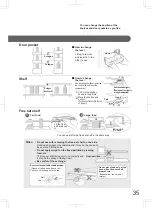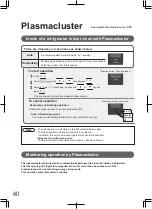
37
Tips for efficient storing food
•
Do not put food contained salt on the stainless steel
tray (plate).
(Because tray or plate may rust)
•
Do not drop food in the compartment.
(This may cause cracking and breakage of case, and
stainless steel plate deformation)
•
Do not make ice by pouring water in the case directly.
(Because the case may be broken)
•
Do not put in canned beers/ alcohol-free soft drinks/
carbonated drinks.
(Because there may be the risk of
explosion)
•
Do not place food with high moisture in the
vicinity of discharge port.
(Because temperature goes down and there may be
the possibility of food freezing)
Specifically if canned beers, alcohol-free soft drinks/
carbonated drinks are frozen, there may be the risk
of explosion.
•
Do not use vegetable compartment
under parts removed.
(Because inside of the compartment
is easy to dry)
•
Do not put oversized food in the
case.
(If food lifts up, this may be the cause
of scratch in the compartment.)
Note
part : Discharge port
(
Back of fresh case)
Intake
port
Discharge
port
Succulent food in the small
article case may also be frozen.
Seal
Use plastic wraps and containers.
This prevents food from drying
and transferring of odors.
Hot food will cause the
compartment temperature to rise.
Hot food will also cause other
food to become damaged.
Cool
Space out food.
All cool air to flow
smoothly
Meats / Fish / Poultry
Place on a plate or dish and cover with paper or plastic wrap. Then, place in the fresh case.
For larger cuts of meat, fish, or poultry, place to the rear of the shelves.
Ensure all cooked food is wrapped securely or placed in an airtight container.
Dairy Products & Eggs
Most dairy products have a use by date on the outer packaging which informs the recommended temperature and
shelf life of the product.
Eggs should be stored in the egg case.
STORING FOOD
Refrigeration reduces the rate of food spoilage. To maximize the shelf life of perishable food products, ensure that
the food is of the freshest possible quality. The following is a general guide to help promote longer food storage.
Fruits / Vegetables
To minimize moisture loss, fruit and vegetables should be loosely enclosed in a plastic material e.g. wrap, bags
(do not seal) and place in the vegetable compartment. Those fruits and vegetables with thick skins e.g. oranges
do not require wrapping.
Quality of foods should be fresh.
Freeze small quantities of food at a time to freeze them quickly.
Food should be properly stored or covered tightly.
Place the food in the freezer evenly.
Label bags or containers to keep an inventory of freezing food.
FOR BEST FREEZING
Freezer compartment
Vegetable compartment
Summary of Contents for SJ-GF60A
Page 55: ......
Page 56: ...Printed in Japan TINSJB478CBRZ 16JK 3 SHARP CORPORATION ...
















































